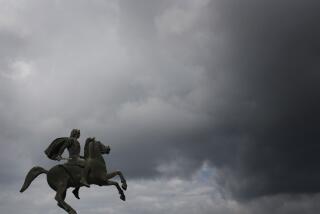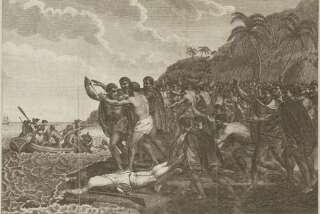Book Review : How Lewis and Clark Conquered a Continent
The Way to the Western Sea: Lewis and Clark Across the Continent by David Lavender (Harper & Row: $22.95, 448 pages)
Let me confess right away that I have a special love for true stories of adventure, exploration and survival. And so I picked up David Lavenderâs new history of the Lewis and Clark expedition, âThe Way to the Western Sea,â with the greatest anticipation. I was not disappointed.
Thomas Jefferson, we are reminded, dispatched Meriwether Lewis and William Clark--and their âCorps of Discovery,â a rag-tag band of soldiers, boatmen, trappers, slaves and Indians--on an extraordinary quest for a route across the mostly unexplored continent to the distant Pacific Ocean. Day by day, night by night, Lavender allows us to accompany these men and women (including the legendary Sacagawea) on their mission of empire-making.
High Drama
The story, of course, is not without its moments of high drama--encounters with angry grizzly bears, the scaling of rugged mountains and sheer cliffs, passages through treacherous stretches of white water in improvised dug-out canoes, and bloody skirmishes with bands of Native Americans who recognized all too well what the coming of the white man would mean to their way of life.
But Lavender is especially successful at showing us the skill, ingenuity and simple courage that were required to survive in the wilderness. He gives us every detail of preparation and innovation, from the portable iron boat that Clark himself designed (aptly named âExperimentâ) down to the expeditionâs food supplies, which included concentrated soup packaged in lead containers that were to be used to make bullets.
On a good day, the best shots were able to bring down more than enough buffalo, deer and elk to satisfy the considerable appetites of men who portaged boats and baggage up and down mountains. (âLike frontiersmen throughout the continent,â Lavender remarks, âthey were helping create, bit by bit, an American attitude with each unnecessary shot they fired.â) On a bad day, the party had nothing at all to eat.
At Jeffersonâs request, Lewis was instructed in medicine by Benjamin Rush, signer of the Declaration of Independence and a pioneer of American science. (Lavender reports that Rush trained about 3,000 physicians in the use of dubious or outrightly dangerous cures, including a particularly potent laxative dubbed âRushâs Thunderbolts.â--âThe harm they inflicted,â Lavender comments in passing, âis incalculable.â) On the trail, the expedition was plagued by venereal disease transmitted by the Indian women who offered themselves--or were offered by their husbands--in encounters that were sometimes commercial and sometimes merely a display of good manners. (âThe offer of a wife,â Lavender explains, âwas a sign of hospitality.â)
Lavender does not overlook the unmistakable political and diplomatic motives of the Lewis and Clark expedition. Its mission was ostensibly scientific--Jefferson, the scientist-President, instructed Lewis and Clark to make detailed observations of the land and the rivers, to gather specimens of flora and fauna, and to make maps. They were to study the Native Americans: âAt what age do women cease to menstruate? Do they ever commit suicide for love? How do they dispose of their dead?â
But, in a secret message to Congress, Jefferson was more forthcoming about the other benefits of what he disingenuously characterized as âa literary pursuit.â Lewis and Clark were the literal vanguard of American imperialism, and their duties included making peace among warring Indian tribes, blazing a trail for fur traders and other American settlers and entrepreneurs, and reconnoitering the territories claimed or dominated by the rival North American empires of Britain, France and Spain.
Yeoman Historian
Lavender, a resident of Ojai and an accomplished chronicler of California and the West, is a yeoman historian with nearly 20 works to his credit. He displays an intimate familiarity with source materials--including the journals of Lewis and Clark--and a mastery of the original scholarship of academic historians who have studied the celebrated expedition. But Lavender is mostly a good storyteller, and, at its best, âThe Way to the Western Seaâ has the rhythm and the gritty detail of a yarn told around a campfire.
Indeed, Lavender displays a peculiar verbal tic that one might expect of someone whoâs accustomed to telling stories out loud--the habitual use of one- or two-word sentences, often as expletives or merely as labels: âLuck!â is the first word in the book. We also come across âMagic!â âBears!â âConsider.â âAssumptions.â âPyrrhic victory.â âGrim times.â By the end, however, this oddity of style struck me as endearing, not annoying--the minor theatrics of an expert spinner of tales. And Lavenderâs book is all the more compelling because the tales are true.

